World of Activity #3: The House of Project Engagement
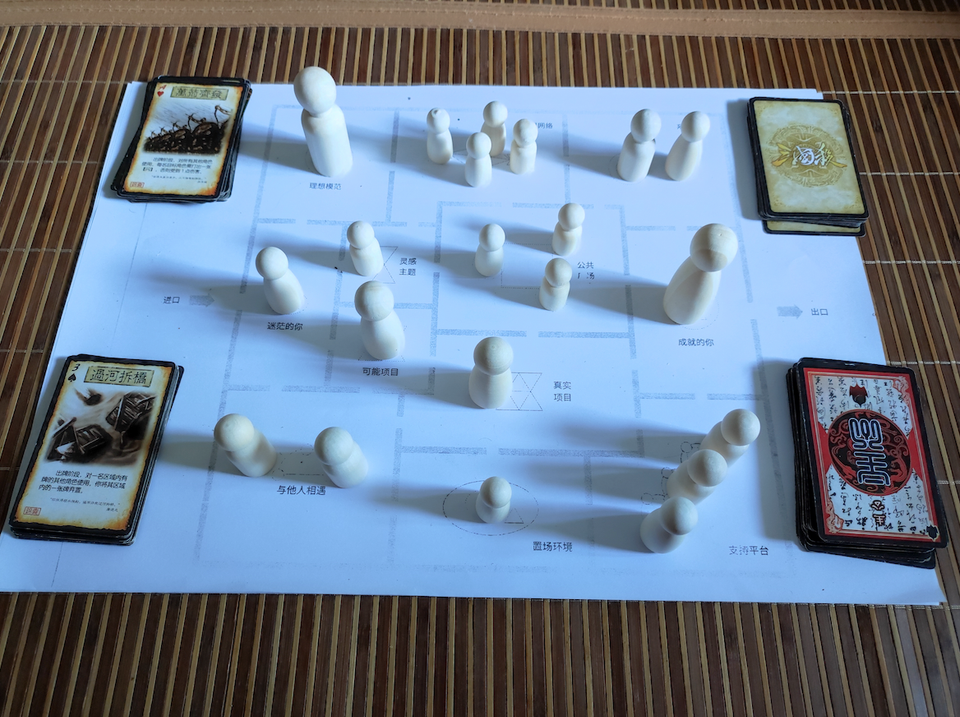
A Thematic Map and an Interactive Tool for Life Narrative Engagement
by Oliver Ding
This article is part of the World of Activity series on the Activity Analysis site. In this series, we use the World of Activity toolkit as a creative heuristic to explore new themes and encourage discussions around resonant topics with your friends and colleagues.
In this article, we introduce the House of Project Engagement, a thematic map and interactive tool for life narrative engagement. The map is an application of the Project Engagement Approach (V3.1).
Contents
1. A Practical Application of the Project Engagement Approach (v3.1)
2. The Development of the House of Project Engagement
3. Maps, Models, and Moves
4. Thematic Room: Boundary, Symbol, and Key Term
5. The "Ideas" Thematic Room
6. The "Possible Project" Thematic Room
7. The "Actual Project" Thematic Room
8. The "Before" Thematic Room
9. The "Role Models" Thematic Room
10. The "After" Thematic Room
11. The "Public Square"
12. Thematic RoomThe "Meet with Others"
13. Thematic RoomThe "Settings" Thematic Room
14. The "Network of Projects" Thematic Room
15. The "Supportive Platform" Thematic Room
16. The "Conflict" Thematic Room
17. The Mapping Strategic Moves Method and Four Case Studies
18. The House of Social Theories
1. A Practical Application of the Project Engagement Approach (v3.1)
The Project Engagement Approach is a project-centered social theory inspired by Andy Blunden's notion of the "project as a unit of analysis of activity." It aims to establish the concept of the "Project" as a theoretical foundation for cross-disciplinary research, creative dialogue, and deep reflection.
The Project Engagement Approach was initiated in 2021. At first, I used the term "Project Engagement" to name the second part of my 2021 book, Project-oriented Activity Theory. In 2022, I developed the v2.1 of the approach to explore the "Project - Project" relationship and other topics.
In May 2024, I developed version 3.1 of the Project Engagement approach. While version 1.0 focused on the Developmental Project Model, version 3.0 expanded on this by curating a range of knowledge frameworks to explore project-oriented social ecology.
This is a comprehensive theoretical toolkit, as illustrated in the diagram below.
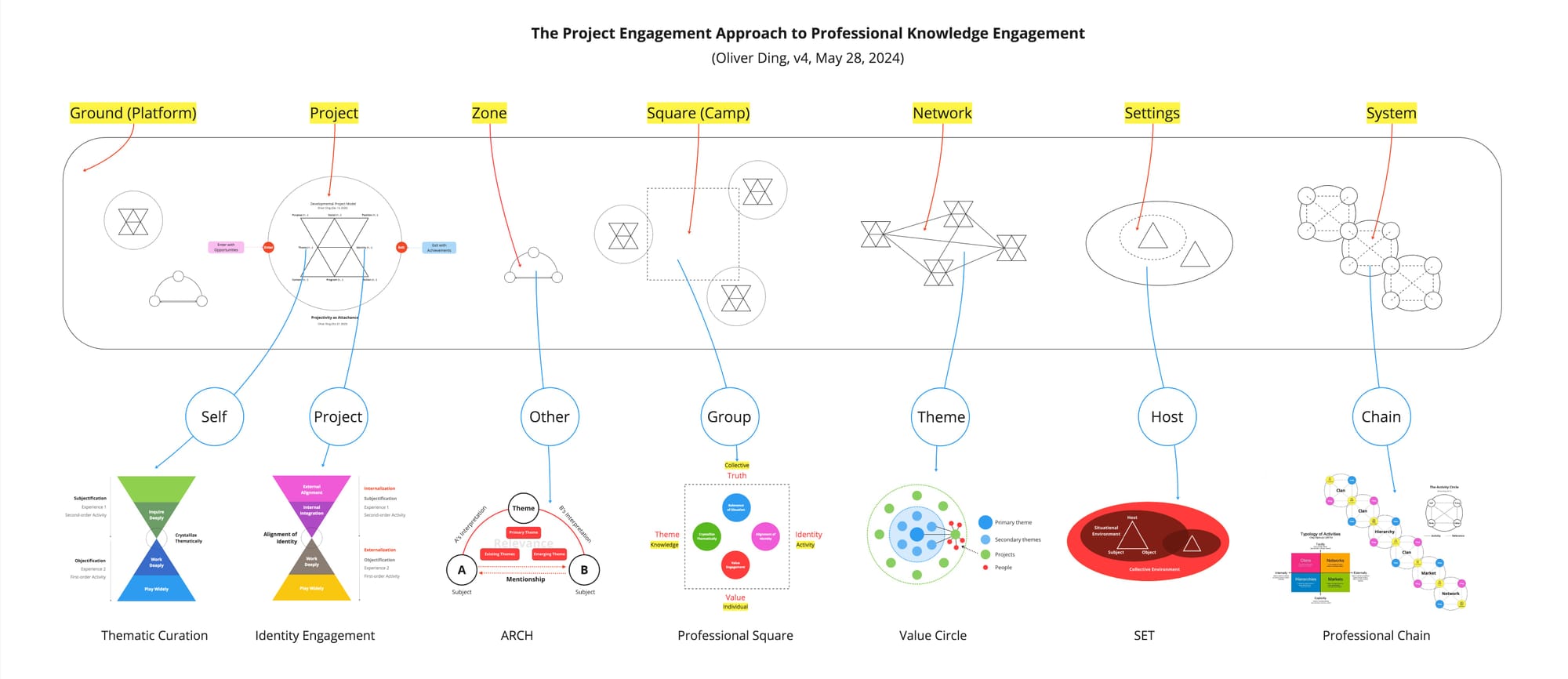
The diagram consists of two key components:
- The top section represents a Map.
- The bottom section showcases several knowledge frameworks.
Between May and June, I collaborated with friends to test this theoretical toolkit in various fields, including higher education teaching, life narrative practices, and youth developmental discovery.
In June 2024, to support a friend’s workshop, I simplified the Project Engagement approach (v3.1) by selecting only its Map component. This led to the creation of the House of Project Engagement. See the diagram below.
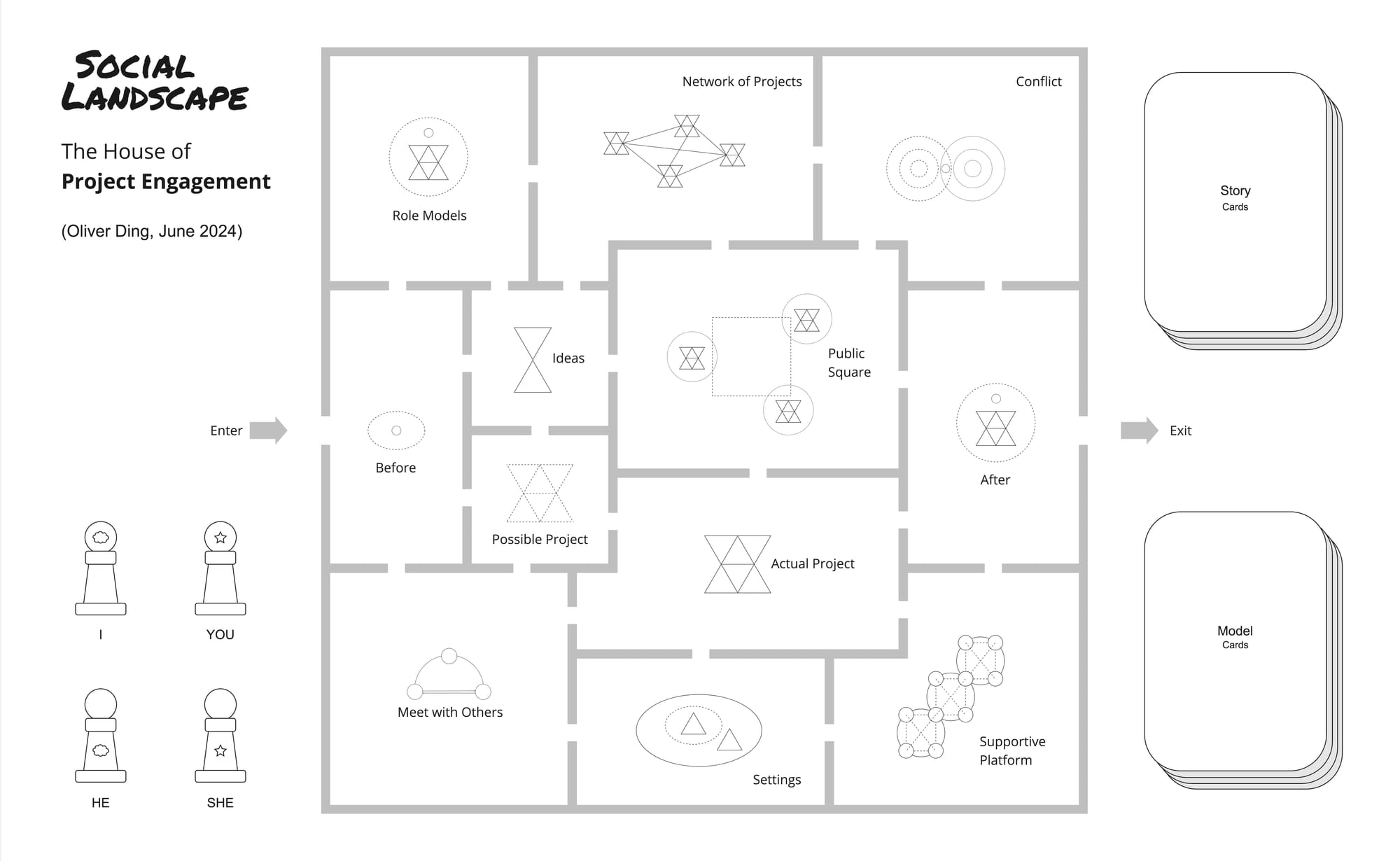
2. The Development of the House of Project Engagement
The development of the House of Project Engagement was intertwined with my trip to China during June and July 2024.
During four weeks, while caring for a family member undergoing surgery, I reflected on the healthcare system through the lens of the House of Project Engagement.
At the same time, I actively worked on designing, discussing, and testing the framework. This process led to the creation of a physical prototype—a tabletop game centered on life narrative practices.
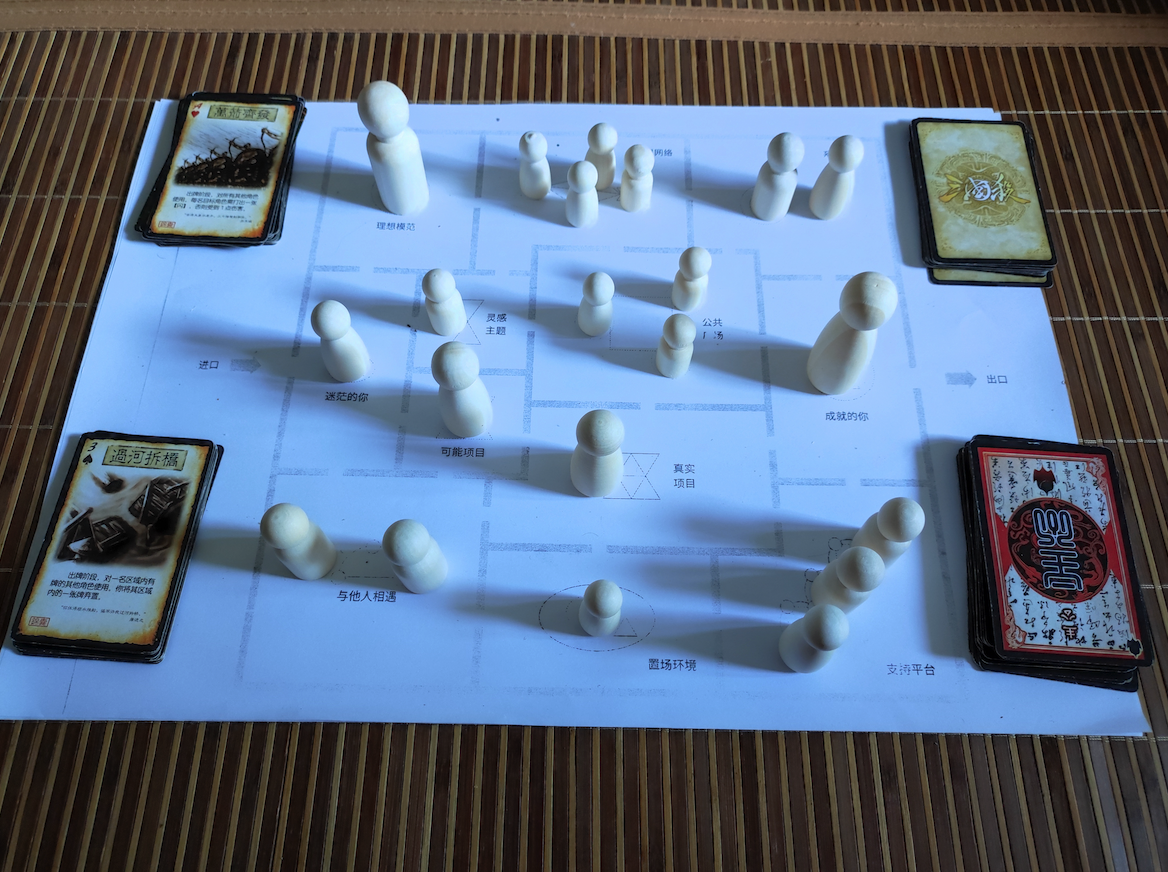
Upon returning to the U.S., I developed an English version of the House of Project Engagement and renamed it Social Landscape: The House of Project Engagement.
In July 2024, after returning to the U.S., I completed Project Engagement (v3.1) with a Chinese-language thesis. However, I detached the concept of Social Landscape from the thesis and developed it into a standalone framework, which I later applied to the Strategic Moves project in September 2024.
The House of Project Engagement inspired me to design a series of thematic maps and knowledge maps, while also developing the "Map - Move - Model - Method - Meaning" schema and a related methodology. These efforts also contributed to the development of Thematic Space Theory.
3. Maps, Models, and Moves
Designed as a Map, the House of Project Engagement uses a “Museum” metaphor to represent space. The House is organized into 12 thematic rooms, with each room representing a distinct type of social landscape. Together, these rooms depict the following themes:
- Before
- Role Models
- Ideas
- Possible Project
- Meet with Others
- Actual Project
- Settings
- Supportive Platform
- Public Square
- Network of Project
- Conflict
- After
The methodology behind the design is framed by the "Map - Move - Model - Method - Meaning" schema.
For example, the diagram below represents 17 Moves in my journey of engaging with Activity Theory.
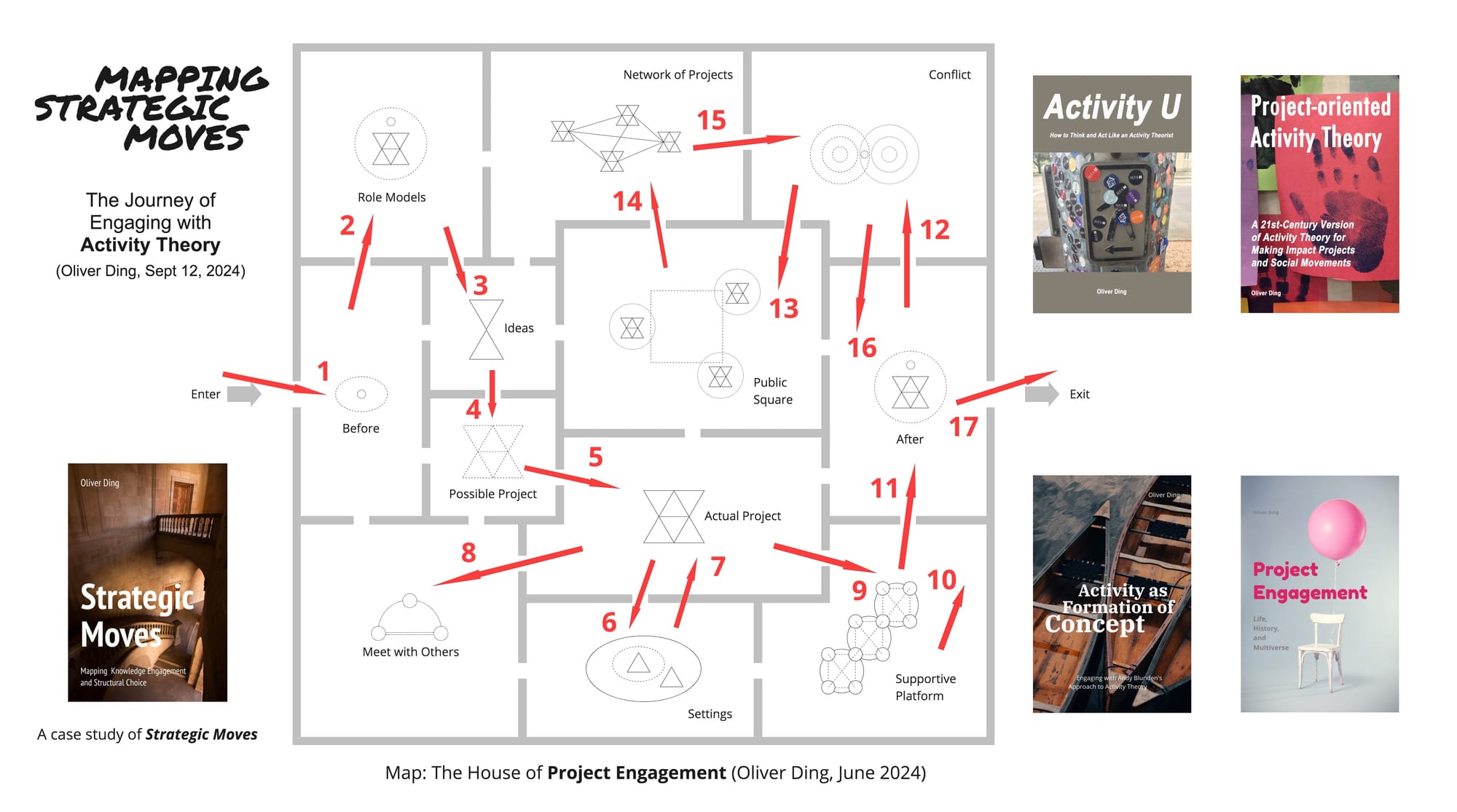
The House of Project Engagement functions as a thematic Map, structured with 12 thematic rooms that represent a series of social landscapes.
Each thematic room can incorporate relevant knowledge frameworks as Models.
The approach of using these 12 rooms to map life courses and creative journeys serves as a distinctive Method. For instance, I developed the Mapping Strategic Moves method within the framework of the House of Project Engagement.
By integrating Maps, Moves, and Reflection, this methodology supports life narrative practices, facilitating the process of Meaning discovery.
4. Thematic Room: Boundary, Symbol, and Key Term
Each thematic room is constructed around three key elements: Boundary, Symbol, and Key Term.

The seed of this idea is the sign of Creative Life Theory, illustrated below.

The above image was designed with three components: a square, a circle, and a sandglass. Each of these elements represents a key aspect of the Creative Life Theory.
- The Square symbolizes the “Lifescope, ” also called the “World of Activity, ” which defines the boundaries of a person’s creative space throughout their life. Find more details, see Lifescope: The World of Activity for Creative Life Curation.
- The Circle represents the “Knowledge Center,” a container for Knowledge Engagement. You can explore this further in TALE: A Possible Theme called “Knowledge Center”.
- The Sandglass signifies the S-T-O Tendency, a core idea of the Creative Life Curation framework.
The Square is used to design 12 thematic rooms for the House of Project Engagement. To reflect additional aspects of human life and the social landscape, I introduced various symbols inspired by the Developmental Project Model diagram.
As a Map for strategic narratives and life narrative practices, I use simple words as Key Terms to highlight the uniqueness of each thematic room. There are no strict rules for interpreting these key terms; they are meant to trigger recall, association, and discussion.
Let’s begin with the “Ideas” thematic room.
5. The "Ideas" Thematic Room
The Key Term “Ideas” refers to an individual’s specific thoughts, such as a theme, concept, insight, intention, strategy, objective, etc.
It can also be associated with abstract ideas such as theoretical concepts, cultural norms, laws, rules, and ideologies that shape social life.
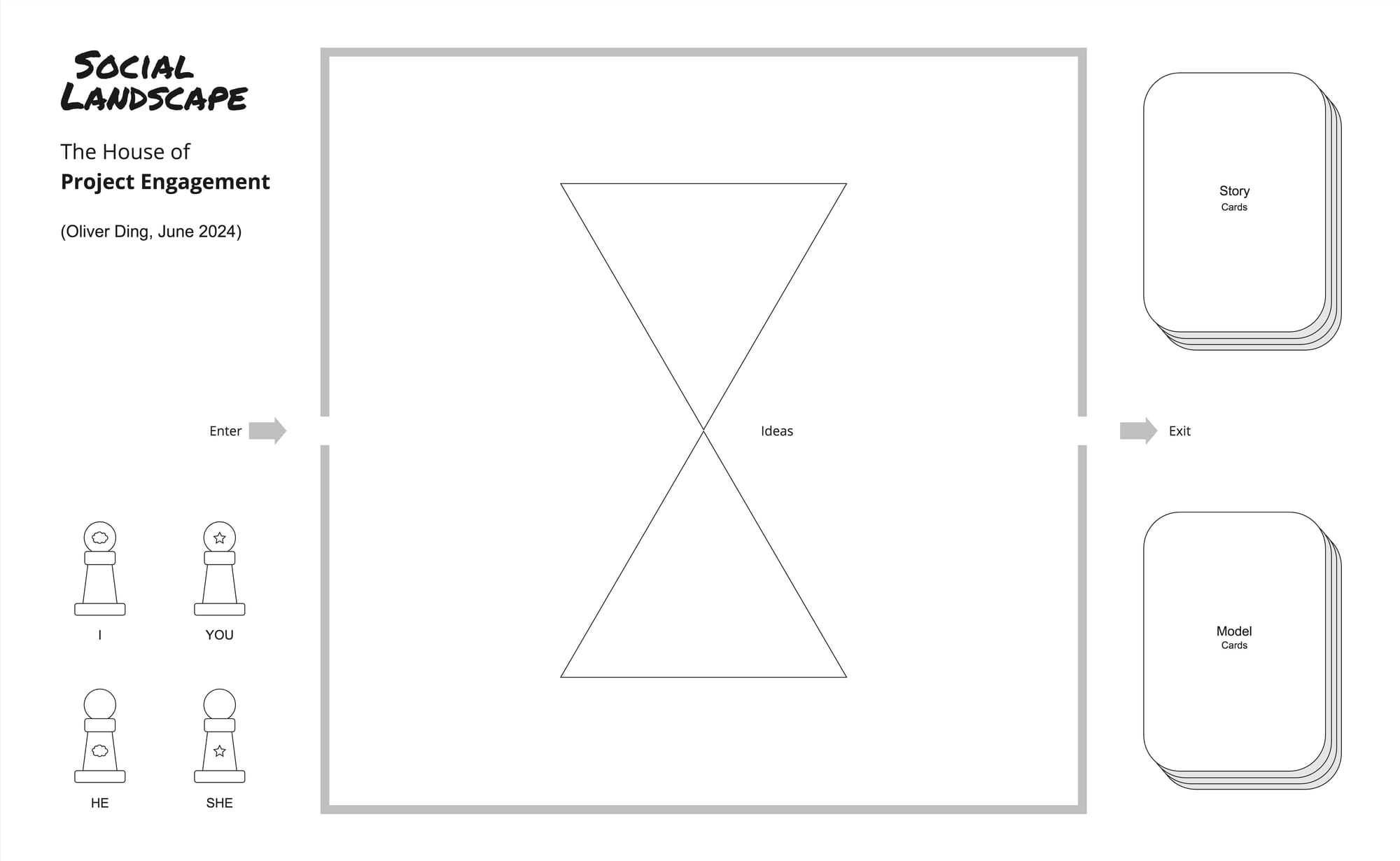
From four case studies, I found that the theme of 'Ideas" can refer to the following things:
- Objective
- Intention
- Strategy
- Concept
- Theme
In general, the key term “Ideas” pertains to what we think, especially ideas that influence our journey. For mapping moves of Project Engagement, we focus on ideas connected to action and project execution.
6. The "Possible Project" Thematic Room
The key term “Possible Project” serves as a bridge between “Ideas” and “Actual Project.”
It encompasses an individual’s anticipations, plans, explorations, experiments, and tentative actions.
When paired with the Key Term “Actual Project” in mapping strategic moves, early-stage, canceled, unfinished, or failed projects can be placed in the “Possible Project” thematic room.
The value of the “Possible Project” lies in tracing the progression from ideas to objectives, from objectives to objects, and from objects to outcomes — including both planned products and unexpected by-products.
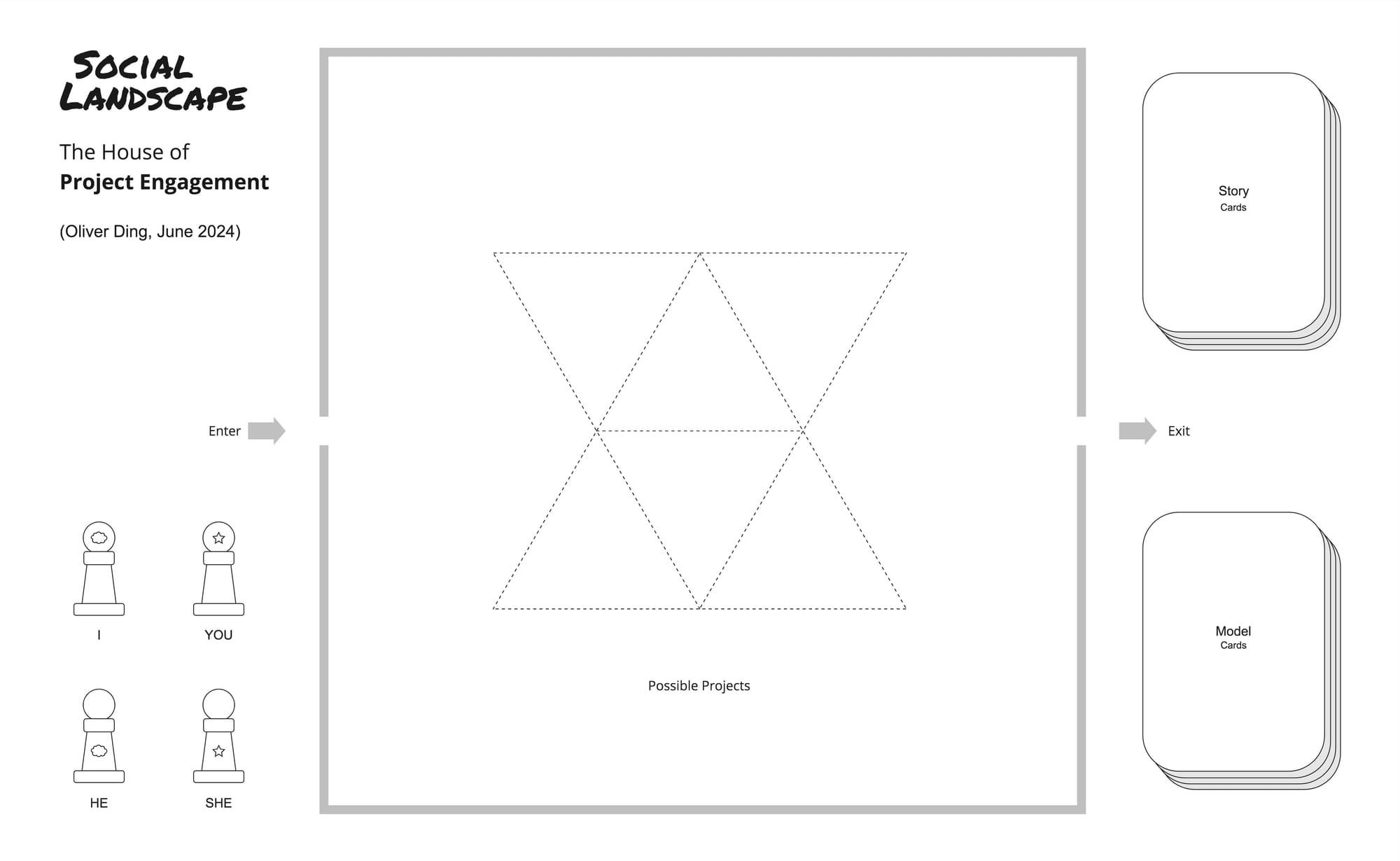
From four case studies, I found that the theme of "Possible Project" can refer to the following things:
- Shifting of Objective
- Prototype
- By-product
- Experiments
- Failed Project
- Unexpected by-product
- Unsatisfied Outcome
- Early-stage project
- Anticipation without Actions
- Exploration
For mapping moves of Project Engagement, the “Possible Project” thematic room is used to explore the adaptability and creativity of strategy.
7. The "Actual Project" Thematic Room
The Key Term “Actual Project” designates the central thematic room of the House of Project Engagement.
Unlike “Possible Project,” which deals with early-stage, canceled, unfinished, or failed projects, the term “Actual Project” refers to long-term, completed, successful projects.
“Actual Project” also includes satisfied outcomes, such as planned products or unexpected by-products.
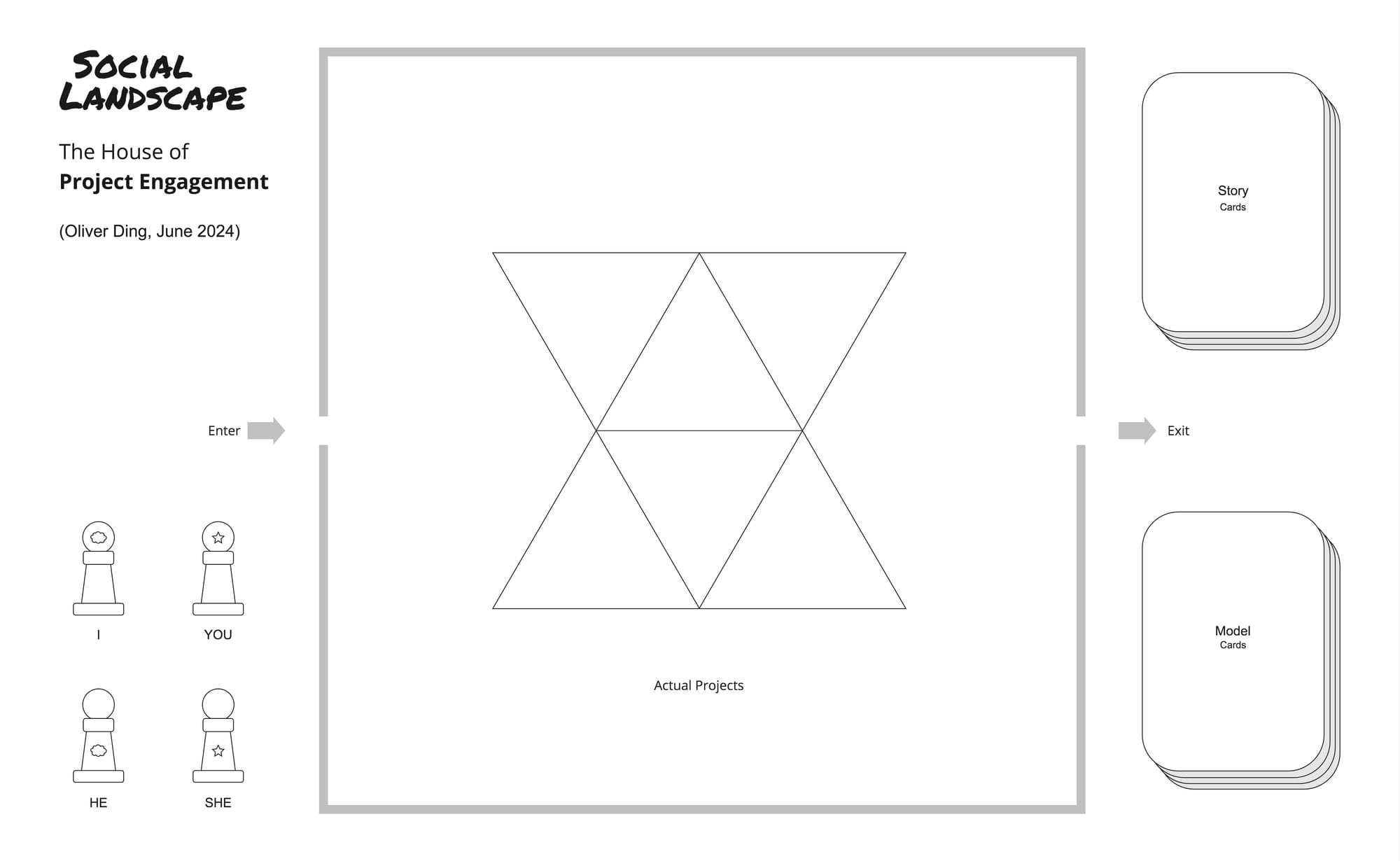
“Actual Project” represents the full realization of an idea into a completed objective.
8. The "Before" Thematic Room
The Key Term “Before” refers to a temporal state before the start of a journey.
On an abstract level, it represents a thematic space where Subjectivity takes center stage, while Socialization is suspended.
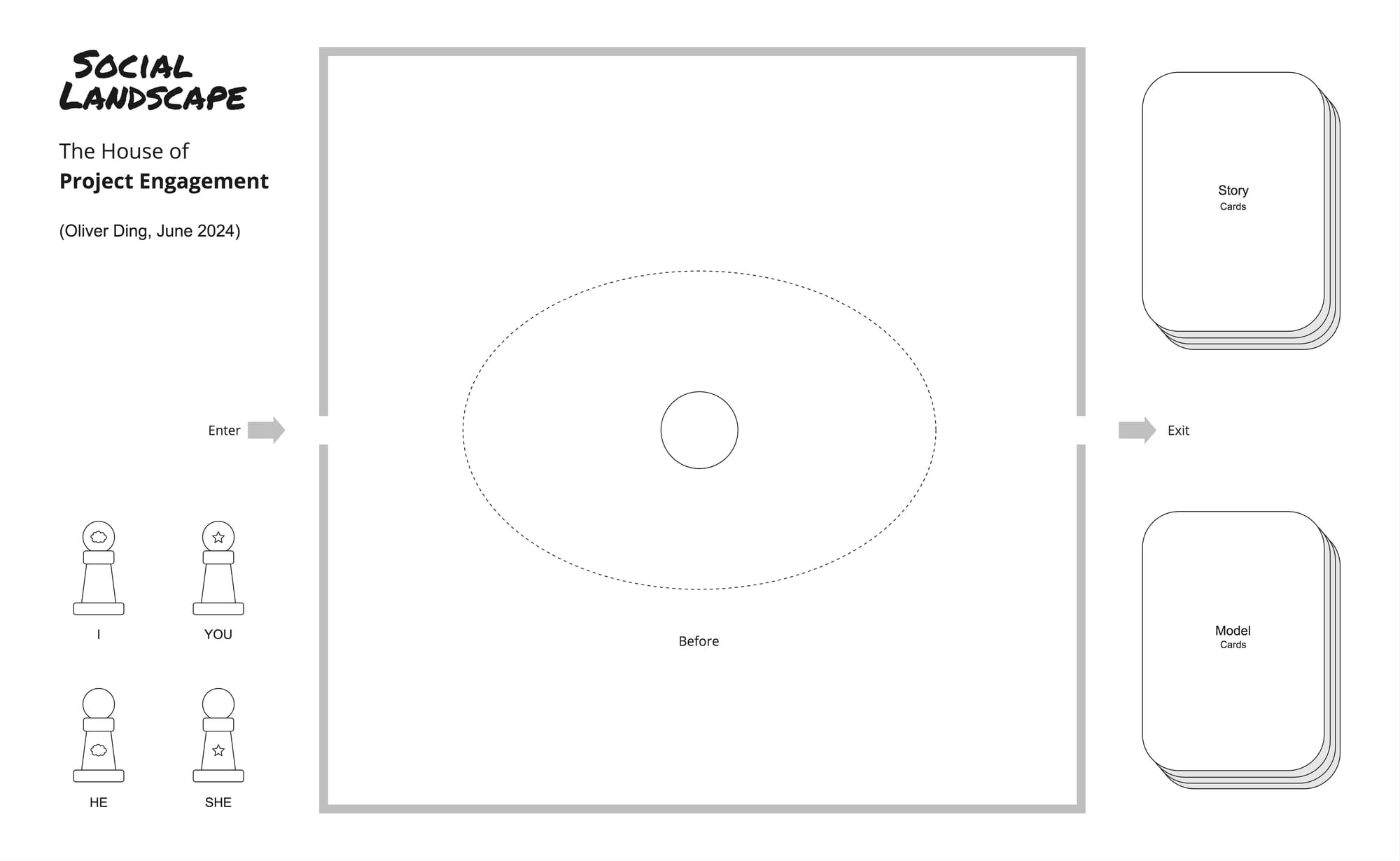
There are no strict rules for interpreting these key terms; they are meant to trigger recall, association, and discussion.
Feel free to interpret it loosely, as it only offers a backdrop for mapping a journey.
9. The "Role Models" Thematic Room
The Key Term “Role Models” refers to ideal figures or models that individuals look up to in their lives.
On an abstract level, it reflects a personal preference for cultural development, as role models symbolize cultural-historical evolution.
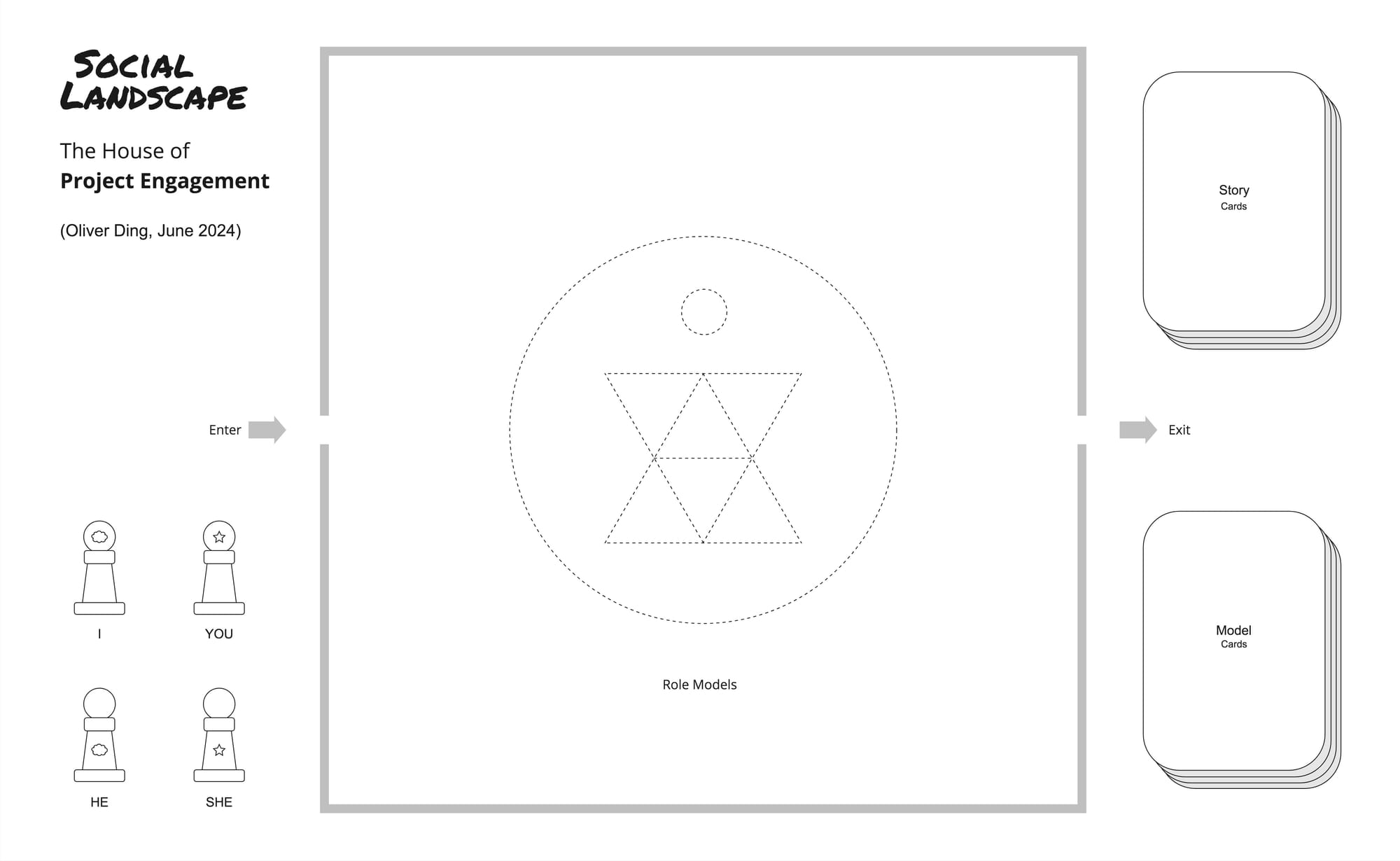
From four cast studies, I didn't mention the "Role Models" thematic room in one case.
There’s no need to reference every thematic room when mapping a journey!
10. The "After" Thematic Room
The Key Term “After” refers to a temporal state that follows the completion of a journey.
On an abstract level, it can be seen as a thematic space where Reflectivity becomes the focus, while socialization is suspended.
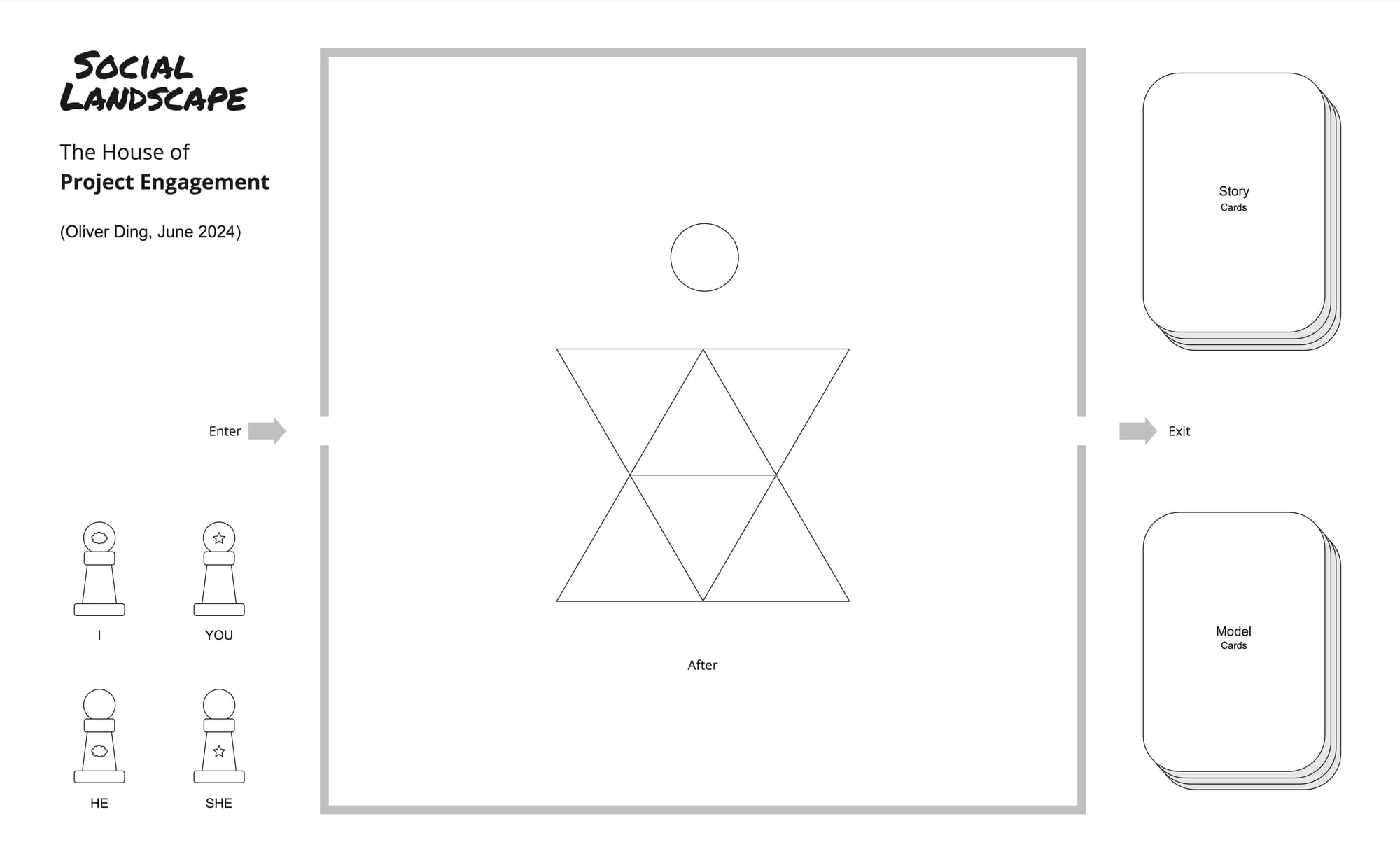
From four case studies, I found the theme of "After" can refer to the following phrases:
- Inspired…
- Envisioned… as my future vocation
- Reflected… generating new creative themes
- Set a vision… over the next five years
- Chose… as the central theme…
- Began thinking about…
- Introduced a new tool…
- After returning to…
- Completed… detached… later applied to…
- Developed…
- Concluded… recognizing…
- Refined… returned… a new theme
It’s clear I was quite active in the “After” thematic room, as it connects both the past and the future.
11. The "Public Square" Thematic Room
The key term Public Square refers to public spaces, both physical and virtual, where individuals — often strangers — engage in social interactions. These spaces, such as parks, social media, and forums, serve as arenas for exchanging ideas, building connections, and shaping public discourse.
In the House of Project Engagement, the Public Square symbolizes an open space for dialogue and the sharing of diverse perspectives.
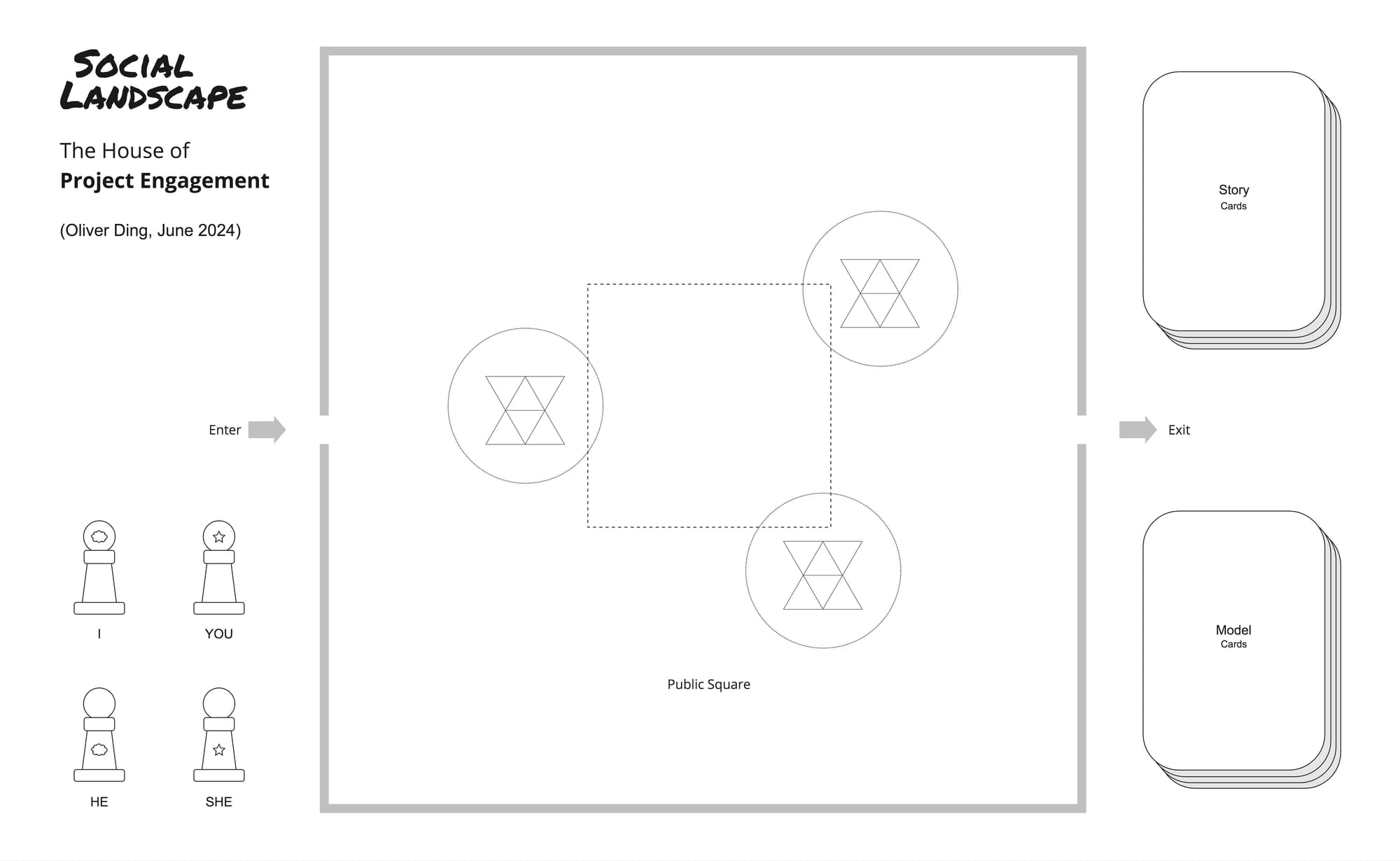
From four case studies, I found the theme of "Public Square" can refer to the following diverse social spaces:
- Linkedin, digital face-to-face interaction, single platform
- An academic field, without direct interaction
- An academic field, with direct interaction
- A social learning program, digital fact-to-face interaction, cross-platform
As noted earlier, “…There are no strict rules for interpreting these key terms; they are meant to trigger recall, association, and discussion.”
Feel free to interpret these terms loosely, as they serve primarily as a backdrop for mapping your journey.
12. The "Meet with Others" Thematic Room
The key term Meet with Others refers to encounters with Significant Others in social life, focusing on meaningful interpersonal interactions that shape our relationships and social experiences.
At a more abstract level, it relates to Intersubjectivity, the shared understanding and mutual awareness that arise during communication, enabling deeper connections and collective meaning-making.
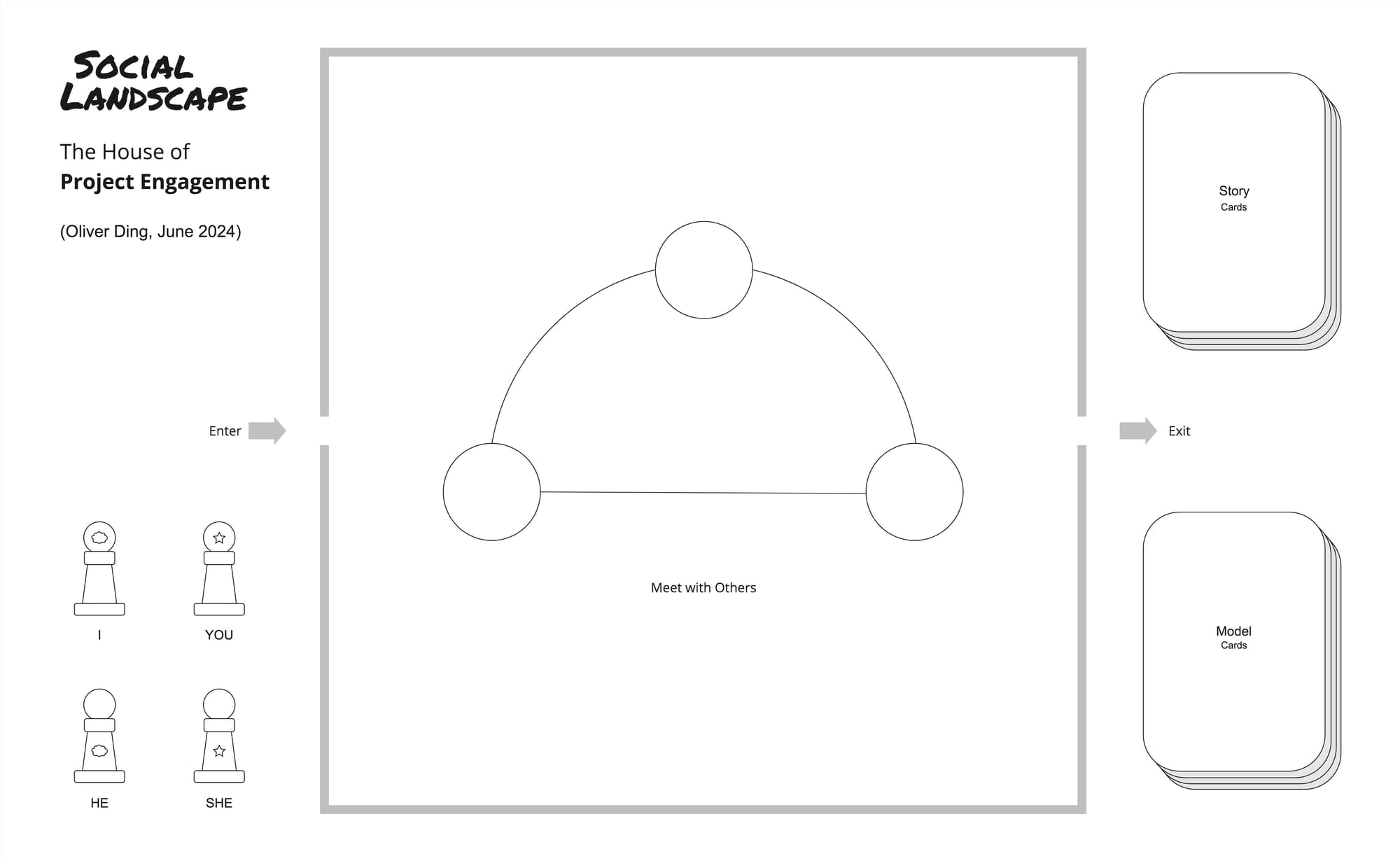
The word “Meet” is used metaphorically in the theme of “Meet with Others.”
In four case studies I conducted in September 2024, I considered both “with direct interaction” and “without direct interaction” as forms of Meetings. Furthermore, “Others” may refer to living people or historical figures.
In 2020, while reflecting on my experience of reading Erving Goffman’s Frame Analysis, I highlighted the challenge of understanding interactions between people and historical figures. I view this as a form of Quasi-social Interaction — though historical figures are people, they cannot respond to us. For more on this, see Frame Analysis in Context.
13. The "Settings" Thematic Room
The key term Settings refers to the environments where individuals act, including both physical spaces and the tools or objects they use. These settings shape behavior by providing context and influencing how people interact with their surroundings and each other.
In the House of Project Engagement, Settings represent the backdrop that frames social actions and collaborations.
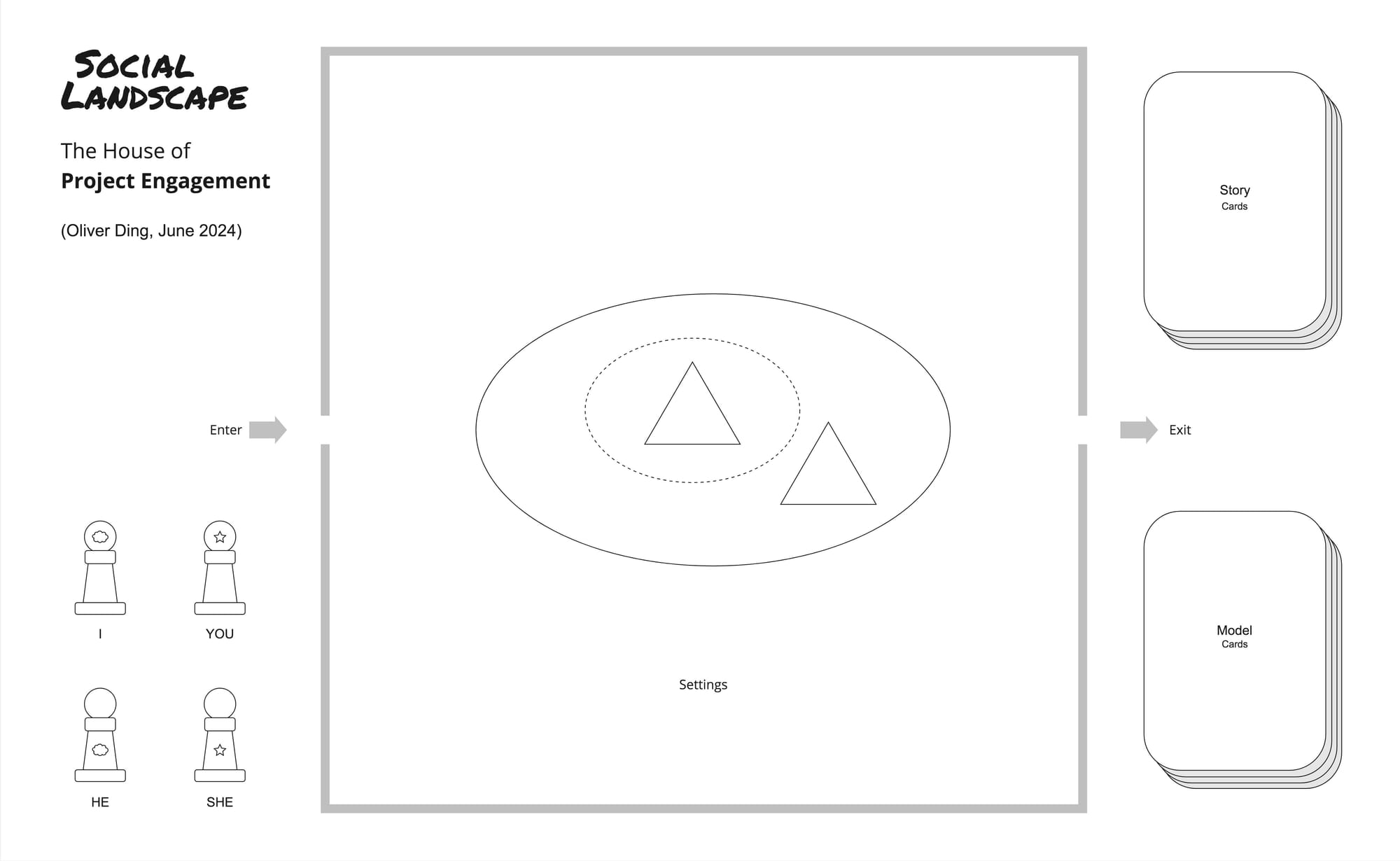
The term Settings is inspired by Ecological Psychologist Roger Barker’s Behavior Settings Theory, which integrates human behavior patterns with physical places.
In the House of Project Engagement, the Settings thematic room covers not only pure physical environments but also settings of routine and organizational contexts.
14. The "Network of Projects" Thematic Room
The key term Network of Projects refers to a network of interconnected projects within social life. These projects can involve a single person or multiple individuals, the latter incorporating broader social networks into the structure of the project network.
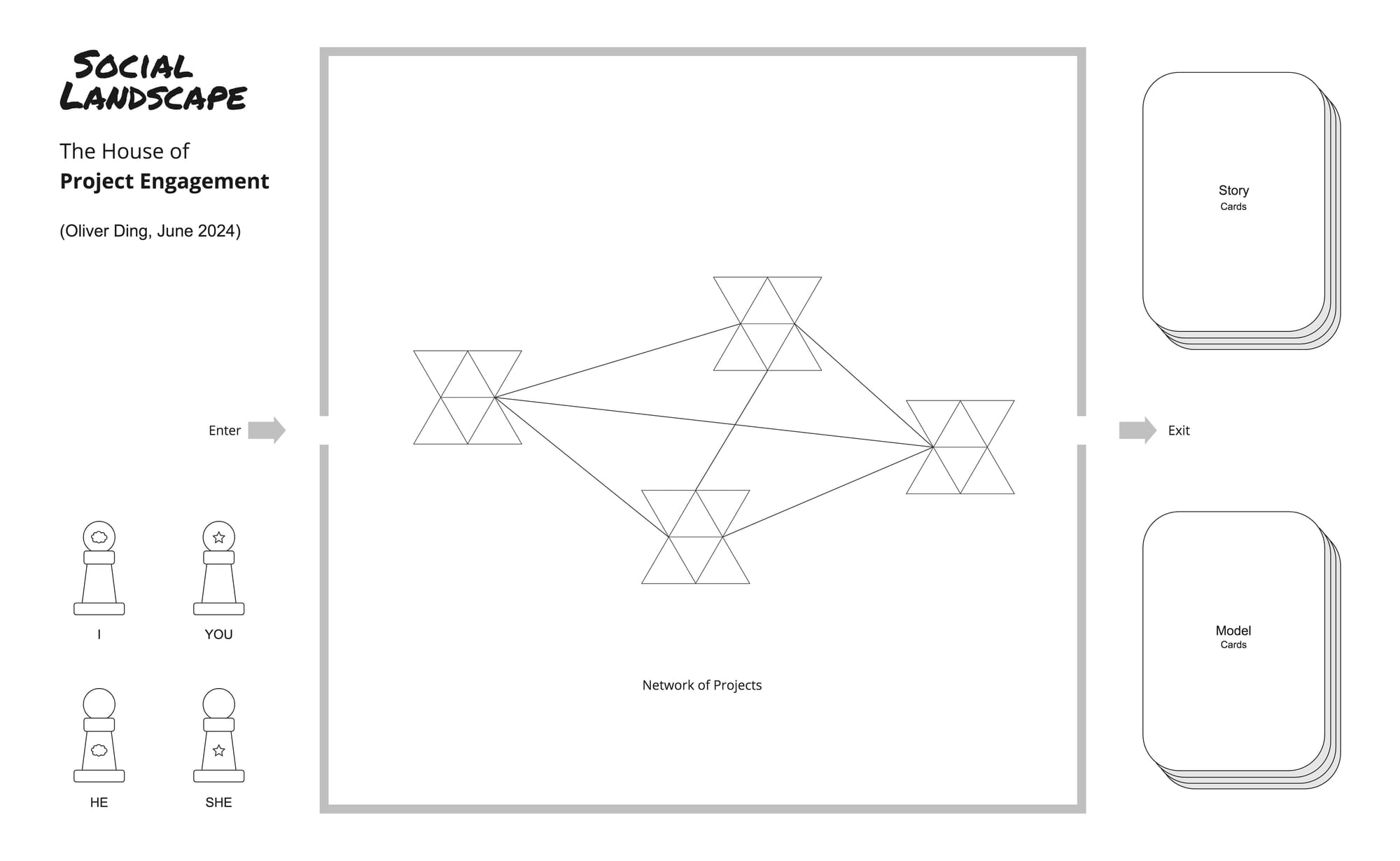
In the House of Project Engagement, the Network of Projects room represents the complexity of networked social interactions as manifested through projects.
15. The "Supportive Platform" Thematic Room
The key term Supportive Platform refers to the social environments or systems that either support or restrict individual actions in social life. These platforms can include families, communities, organizations, and other social structures.
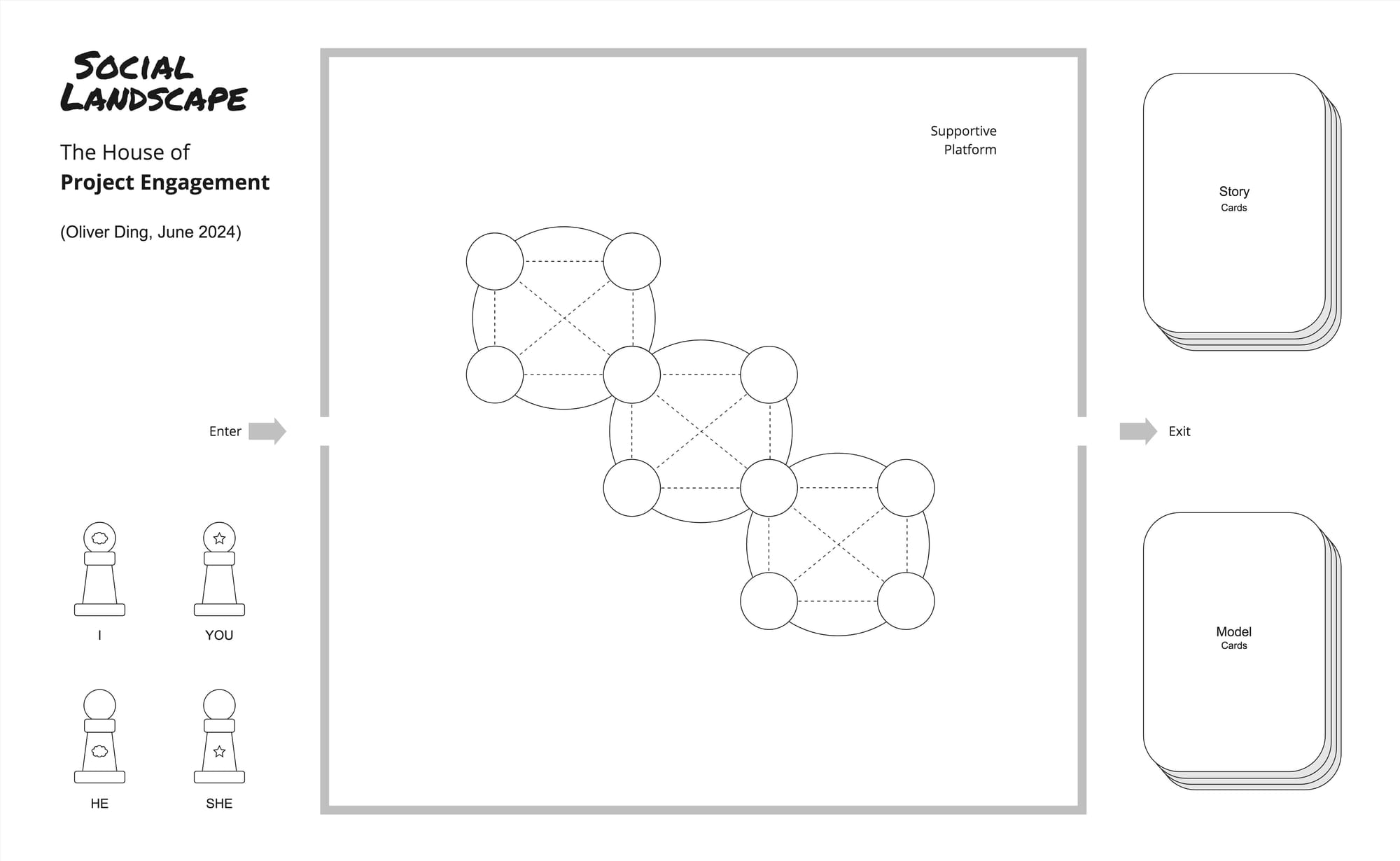
In addition, we can consider Theory as a form of Supportive Platform, particularly from the perspective of Development Platforms.
16. The "Conflict" Thematic Room
The key term Conflict represents the contradictions, oppositions, and challenges individuals face in social life. These conflicts can arise between two social systems, two individuals, or two ideas — such as differing theories or beliefs.
In the House of Project Engagement, Conflict symbolizes both the opportunities and threats that emerge from structural oppositions within social interactions.
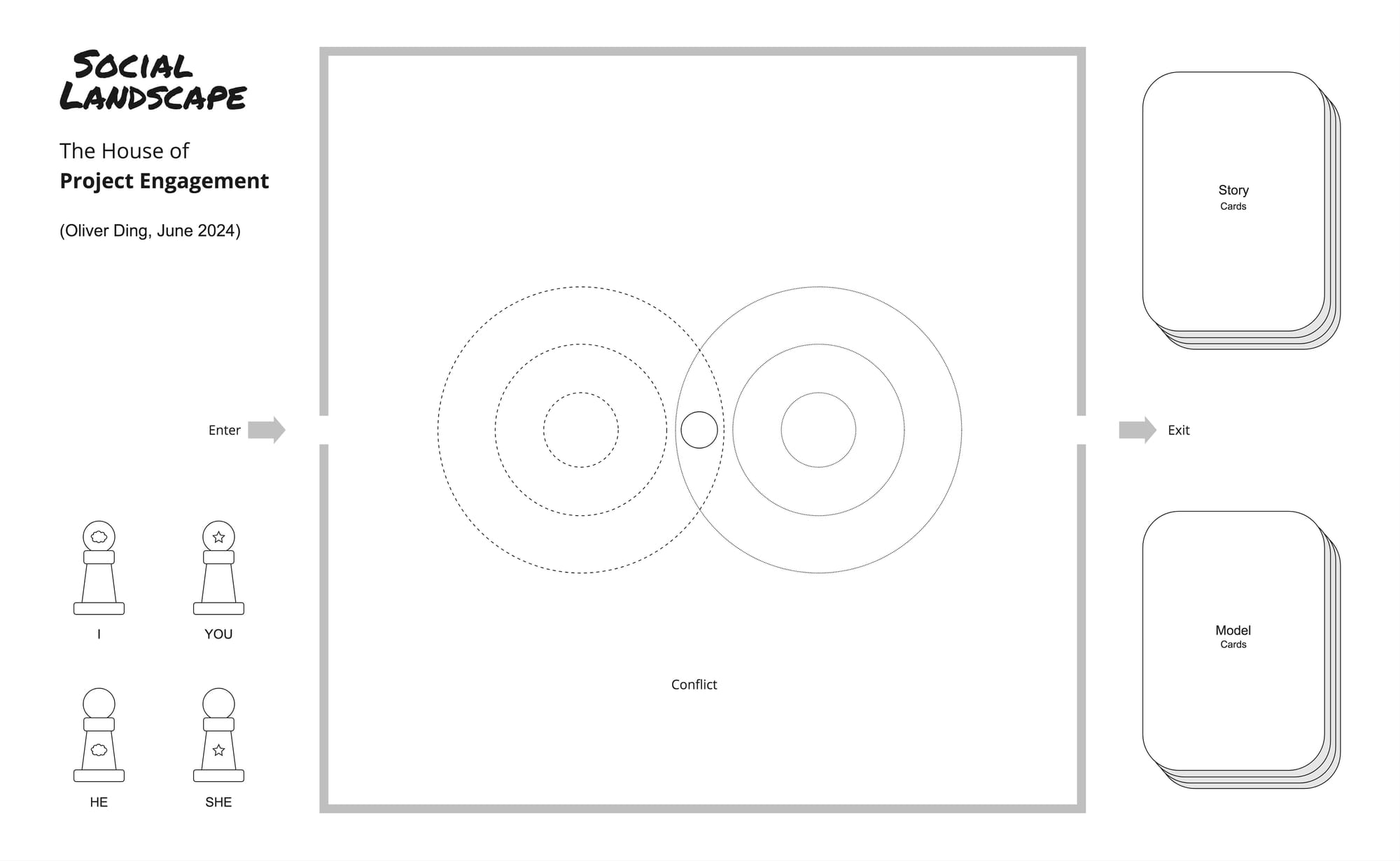
Conflicts of all kinds can be represented as pairs of opposing themes, creating Structural Tensions such as boundaries, distances, differences, heterogeneity, contradictions, and complementarities. If we can turn these structural tensions into creative opportunities, we unlock pathways to personal innovation.
For more details, see The “Activity — Opportunity” Thematic Dialogue and Personal Innovation as Career-fit.
17. The Mapping Strategic Moves Method and Four Case Studies
In September 2024, I utilized the House of Project Engagement as a strategic narrative tool to conduct four case studies. This process led to the development of the Mapping Strategic Moves method. The insights and outcomes were compiled into a book draft titled Strategic Moves: Mapping Knowledge Engagement.
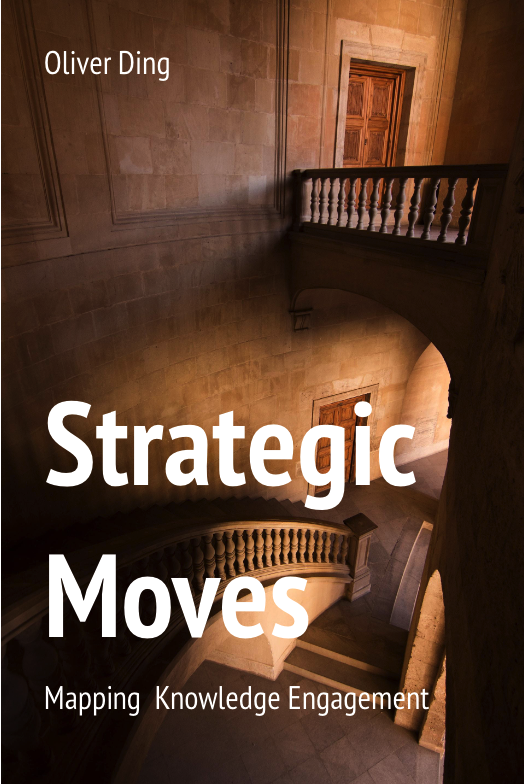
I made the prototype of the method by using the House of Project Engagement to map my strategic moves within four creative journeys from 2019 to 2024.
The Mapping Strategic Moves method is designed to help knowledge creators develop a forward-thinking life strategy by reflecting on their past while connecting it to future possibilities. From this perspective, I introduce the following four themes for reference:
- Modeling a Strategic Journey
- Building a Creative Identity
- Finding Relevant Meaning
- Developing a Value Circle
Each theme is associated with a three-thematic room path.
- The “Ideas — Possible Project — Actual Project” Path
- The “Before — Role Models — After” Path
- The “Public Square — Meet with Others — Settings” Path
- The “Network of Projects — Supportive Platform — Conflict” Path
This is a great example of using the House of Project Engagement.
18. The House of Social Theories
As a thematic map, the House of Project Engagement was initially developed for Life Narrative Engagement, including Strategic Life Narrative.
However, I found that it could be used for knowledge curation projects!
In August 2024, I used it to develop the House of Social Theories. I organized various theoretical resources on the concept of [Social Landscape], consolidating them into the [Social Landscape Framework].
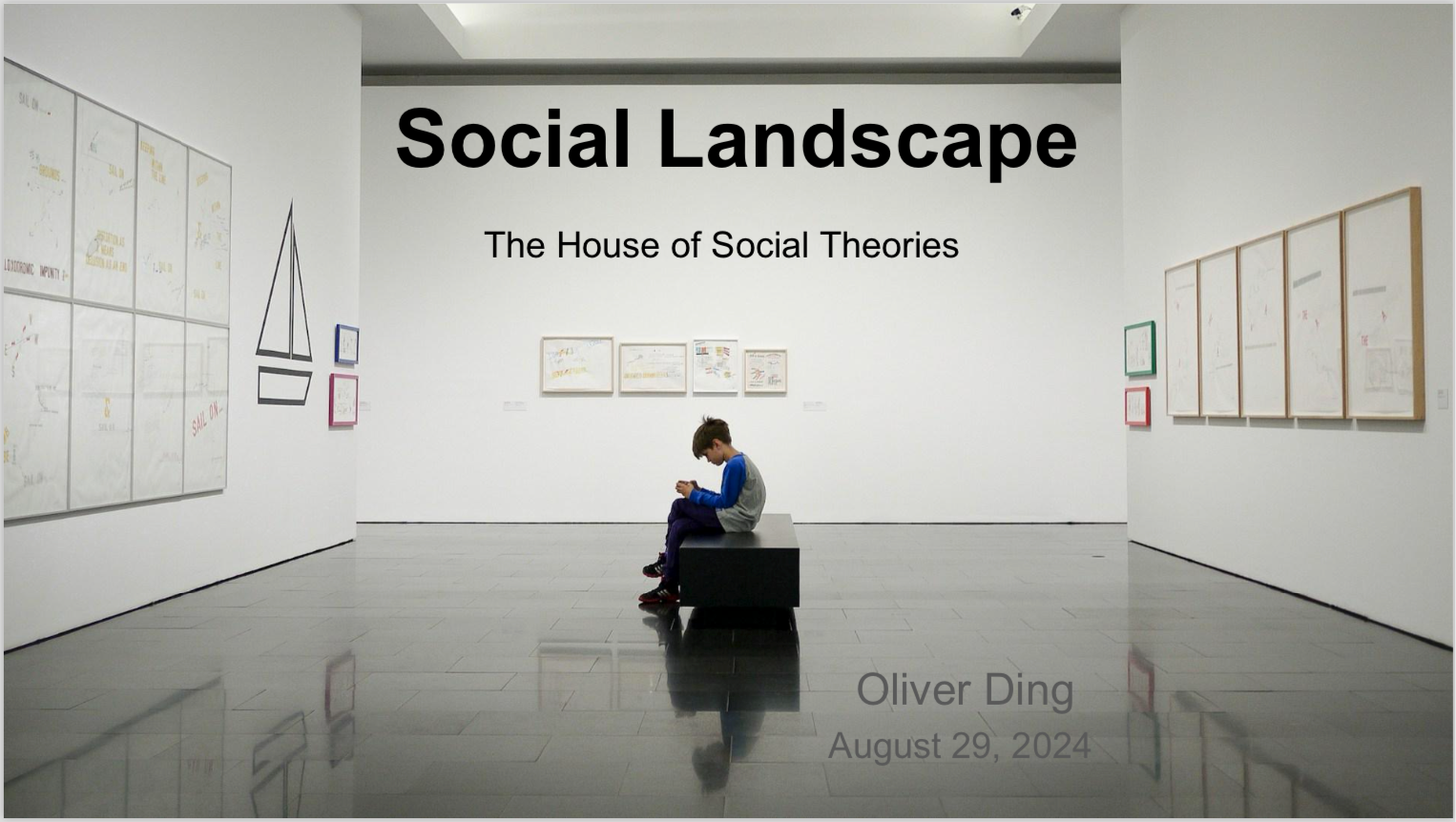
If you want to support my exploration on the House of Social Theories, you can purchase the 90-slide conceptual deck on Possible Press.
In the final section of the [Social Landscape: the House of Social Theories], during a theoretical reflection, I realized that the Social Landscape project is essentially a literature review for the Project Engagement (v3.1) toolkit.

There is a “Part—Whole” Attachance in this journey.
On June 14, 2024, I designed the first version of the House of Project Engagement with 12 thematic rooms, inspired by the “Map” part of the Project Engagement (v3.0) theoretical toolkit. The “Frameworks” part of the toolkit doesn’t appear in the House. At that time, I considered the “Part-Whole” issue inside the Project Engagement project.
On August 27, 2024, I realized that the 12 thematic rooms of the House could be used to curate various social theories. At that moment, the Project Engagement v3.0 theoretical toolkit became a part of a larger entity: the field of Social Theories. My mental focus moved from the inside of Project Engagement to the outside of it.
(2,794 words, February 7, 2025)
